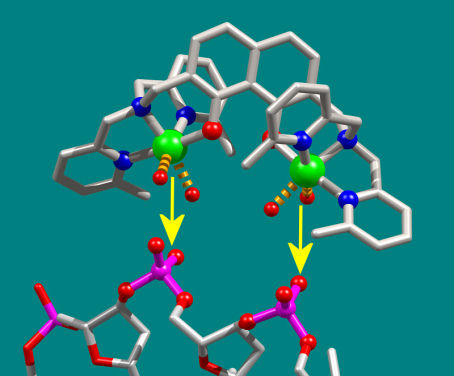Chemists from the German University at Bielefeld have developed a molecule containing copper that binds with DNA and prevents the spread of cancer. First results show that it binds to DNA much stronger than cisplatin and kills the cancer cells at lower concentrations than cisplatin -- a widely used anti-cancer drug that is frequently administered in chemotherapy.
Background:Cisplatin has been used as a chemotherapy agent for cancer for over 30 years. While the drug is effective against certain cancers - such as lung cancer and testicular cancer - it does neither work for all cancers nor for all patients.
Also, cisplatin is not without side effects - it often causes nausea, vomiting and diarrhea and is toxic to kidneys and ears. Another complication of cisplatin is that of drug resistance - a problem that often emerges with drugs that have been widely used for a long time.
The new candidate drug for chemotherapy:
The serious side effects of cisplatin where the motivation for the researchers, led by Thorsten Glaser, professor in inorganic chemistry at the University of Bielefeld to design a new molecule, says Glaser and continues that his group "wanted an agent that would treat cancers that have become immune to cisplatin though its use in earlier treatments".
The new copper-containing molecule attacks the DNA of cancer cells but in contrast to cisplatin does not bind with the nucleobases of DNA but binds to the phosphate of the DNA. The team designed the molecule by integrating two copper atoms that preferentially bind with phosphates on the DNA - like a key that fits uniquely inside a lock. This binding interferes with the cellular processes of the cancer cell so it cannot replicate itself, and it eventually dies.

The new agent containing two copper atoms (above) ‘docks’ precisely with the DNA molecule (below) of a cancer cell and stops it from growing. As a result, the cancer cell dies. Credit: Bielefeld University
|
The copper ions sit at two points protruding from the molecule - like a horseshoe presenting its two ends (see the figure). The distance between the two points of the "horseshoe" is exactly the same as the distance between the phosphates in the DNA, so the molecule docks snugly onto the DNA. "Because two phosphates bind simultaneously, the binding strength is greater and that increases the efficacy," says Prof. Glaser.
The scientists have developed a procedure for manufacturing the new molecule and also demonstrated the activity to prevent cancer cells from spreading. The result was that "the copper complex is more effective than cisplatin," says Glaser. "The highest number of cancer cells died at a concentration of 10 micromolar. With cisplatin, you need 20 micromolar."
However, he also cautions that while the results in the lab show promise, their work is basic research: "How and whether the copper complex will actually be given to cancer patients is something that medical research will have to determine in the years to come."
When carrying out the research on the new agent, Professor Glaser and his team cooperated with the research teams of Professor Dr. Dario Anselmetti (Biophysics and nanoscience) and Professor Dr. Gabriele Fischer von Mollard (Biochemistry) -- both also at Bielefeld University. Dario Anselmetti's colleagues used atomic force microscopy to produce the images confirming that the copper complex binds with the DNA. Gabriele Fischer von Mollard's team tested how the cancer cell culture responded to the agent.
Source:
The above story is based on materials provided by the University of Bielefeld.
 The cited study:
The cited study:

Thomas Jany, Alexander Moreth, Claudia Gruschka, Andy Sischka, Andre Spiering, Mareike Dieding, Ying Wang, Susan Haji Samo, Anja Stammler, Hartmut Bögge, Gabriele Fischer von Mollard, Dario Anselmetti, Thorsten Glaser,
Rational Design of a Cytotoxic Dinuclear Cu2Complex That Binds by Molecular Recognition at Two Neighboring Phosphates of the DNA Backbone, Inorg. Chem., 54/6 (2015) 2679-2690.
DOI: 10.1021/ic5028465 Related EVISA Resources
Related EVISA Resources
 Brief summary: Speciation analysis for the study of metallodrugs and their biomolecular interactions
Brief summary: Speciation analysis for the study of metallodrugs and their biomolecular interactions Brief summary: Chemical speciation analysis for the life sciences
Brief summary: Chemical speciation analysis for the life sciences Link database: Toxicity of platinum compounds
Link database: Toxicity of platinum compounds  Glossary: Metallodrugs
Glossary: Metallodrugs
 Journal Database: Journals related to Medicinal Chemistry
Journal Database: Journals related to Medicinal Chemistry
 Journal Database: Journals related to Pharmacology and Pharmacy
Journal Database: Journals related to Pharmacology and Pharmacy
 Journal Database: Journals related to Oncology
Journal Database: Journals related to Oncology
 Journal Database: Journals related to Metallomics
Journal Database: Journals related to Metallomics
 Link Database: Research groups working on metallodrugs
Link Database: Research groups working on metallodrugs
 Directory of scientists: Researchers working on metallodrugs
Directory of scientists: Researchers working on metallodrugs
 Link page: All about Pharmacy and Pharmaceutical Sciences
Link page: All about Pharmacy and Pharmaceutical Sciences
 Related EVISA News
Related EVISA News
 October 14, 2013: Speciation analysis for cancer diagnosis
October 14, 2013: Speciation analysis for cancer diagnosis January 10, 2007: Dartmouth researchers find that arsenic triggers unique mechanism in rare leukemia
January 10, 2007: Dartmouth researchers find that arsenic triggers unique mechanism in rare leukemialast time modified: January 15, 2024